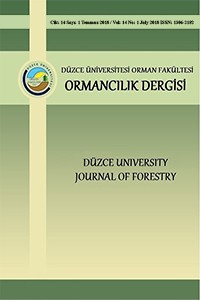Abstract
Heat treatment was
applied without addition of chemicals harmful to human and environmental health,
which are considered as an alternative to the impregnation process has many
advantages and disadvantages for the wood based panel products. Formaldehyde
has been linked to human health and environmental problems during and after
manufacturing. Many studies are applied to reduce the formaldehyde emission. Because
of the different applications of heat treatment, it has not been found in these
studies. In this study, the effects of heat treatment on the formaldehyde
emission rate released on the surfaces of beech (Fagus orientalis Lipsky.) three-layer
particleboard were investigated. For this purpose, three groups were formed
according to different time and temperature of heat treatment. After heat
treatment, the lower, upper and middle layers of panels in the groups were
separated then the formaldehyde emission rates from these layers were
determined and compared with the control groups were not applied heat treatment.
Consequently, the formaldehyde emission rates from the particleboard varied by layer
(the lower, upper and middle) with heat treatment. The formaldehyde molecules
in the upper layers treated at 150°C flowed from the hot side to the cold side. The
formaldehyde emission rates in the heat-treated layers decreased with the time
of treatment.
References
- Aydin, I., Demirkir, C., Colak, S. and Colakoglu, G. 2010. Evaluation of flours of different wood barks as filler in plywood panels. III. National Karadeniz Forestry Congress, Artvin, 5: 1825-1833. Aydin, I., Colakoglu, G., Colak, S. and Demirkir, C. 2006. Effects of moisture content on formaldehyde emission and mechanical properties of plywood. Building and Environment, 41: 1311–1316. Brinkmann, E. 1978. Herstellung von Harnstoffharz-gebundenen Holzspanplatten mit niedrigem formaldehydgehalt auf ein-etagen-anlagen. Holz Roh-Werkstoff, 36: 296-298. Colak, S. 2002. The effects of impregnation procedure at plywood on technological properties, formaldehyde and acid emission of plywood. PhD Thesis, Karadeniz Technical University. Costa, N., Pereira, J., Ferra, J., Cruz, P., Martins, J., Magalhães, F., Mendes, A. and Carvalho, L. 2013. Scavengers for achieving zero formaldehyde emission on wood-based panels. Wood and Science Technology, 47:1261–1272. EN 322, 1993. Wood-based panels – Determination of moisture content, Brussels, Belgium. EN 717-3, 1996. Wood-based panels, determination of formaldehyde release, formaldehyde release by flask method. Brussels, Belgium. FAO 2016. FAOSTAT-FAO Statics Division - Production Quantity/Plywood. http://www.fao.org/faostat/en/#data/FO/visualize. Jiang, T., Gardner, D. J. and Baumann, M. G. D. 2002. Volatile organic compound emission arising from the hot-pressing of mixed-hardwood particleboard. Forest Products Journal, 52.11/12: 66. Kollman, F., Kuenzi, E. W. and Stam, A. S. 1975. Principles of wood science and technology. Springer Verlag. Berlin. New York. Marutzky, R. 1994. Release of formaldehyde by wood products. Forest Product Society, Report No: 94RS100R. Meyer, B., Johns, W. E. and Woo, J. K. 1980. Formaldehyde release from sulfur modified urea-formaldehyde resin systems. Forest Products Journal, 30(3): 24–31. Myers, G. E. 1984. How mole ratio of UF resin affects formaldehyde emission and other properties: literature critique. Forest Products Journal, 34(5): 35-41. Park, B. D., Chang, K. E. and Yong, P. J. 2006. Effects of formaldehyde to urea mole ratio on thermal curing behavior of urea–formaldehyde resin and properties of particleboard. Journal of Applied Polymer Science, 101(3): 1787-1792. Petersen, H. 1973. Zur formaldehyde absplatung bei der spanplattenerzeugung mit Harnstoff-formaldehyde-bindemitteln. Holz als Roh-und Werkstoff, 32(10): 402–10. Petinarakis, J. H. and Kavvouras, P. K. 2006. Technological factors affecting the emission of formaldehyde from particleboards. Wood Research, 51(1): 31-40. Philip, J. R. and De Vries, D. A. 1957. Moisture movement in porous materials under temperature gradients. Eos, Transactions American Geophysical Union, 38(2), 222-232. Que, Z., Furuno, T., Katoh, S. and Nishino, Y. 2007. Effects of urea–formaldehyde resin mole ratio on the properties of particleboard. Building and Environment, 42(3): 1257-1263. Roffael, E. 1975. Messung der formaldehyde hydabgabe. Holz-zentralblatt, 100(96): 1461-2. Roffael, E. 1982. The formaldehyde emission of particleboard and other materials. DRW –Verlag. Stuttgart. p, 154. Salem, M. Z. M., Böhm, M., Beránková, J. and Srba, J. 2011. Effect of some manufacturing variables on formaldehyde release from particleboard: relationship between different test methods. Building and Environment, 46: 1946- 1953. Sundin, B. and Hanetho, P. 1978. Formaldehyde emission from particleboard and other building materials. In: Maloey TM, editor. Proceedings of the 12th International Particleboard Symposium. Washington State University: Pullman, WA: 251–86. Tekin, A. and Keskin, H. 2015. Effects of temperature and humidity on formaldehyde emission from composite furniture components. Proceedings of the 27th International Conference Research for Furniture Industry, Ankara, Turkey: 126-136. Wålinder, M. 2000. Wetting phenomena on wood – Factors influencing measurements of wood wettability, PhD, KTH-Royal Institute of Technology, Dept. of Manufacturing Systems, Wood Technology and Processing, SE-100 44, Stocholm. Wang, W. and Gardner, D. J. 1999. Investigation of volatile organic compound press emissions during particleboard production. Part 1. UF-bonded southern pine. Forest Products Journal, 49(3): 65. Wolcott, J. J., Motter, W. K., Daisy, N. K., Tenhaeff, S. C. and Detlefsen, W. D. 1996. Investigation of variables affecting hot-press formaldehyde and methanol emissions during laboratory production of urea-formaldehyde-bonded particleboard. Forest Products Journal, 46(9): 62.
Details
| Primary Language | English |
|---|---|
| Journal Section | Effect of Heat Treatment on Formaldehyde Emission in Particleboard |
| Authors | |
| Publication Date | July 31, 2018 |
| Published in Issue | Year 2018 Volume: 14 Issue: 1 |

